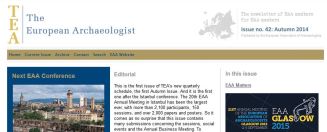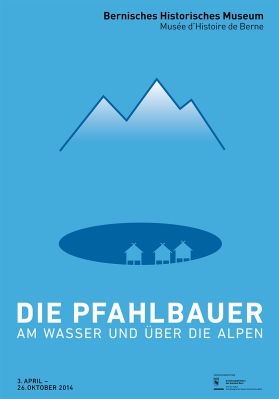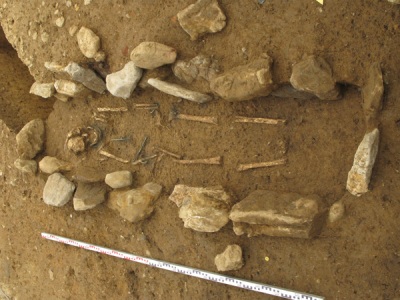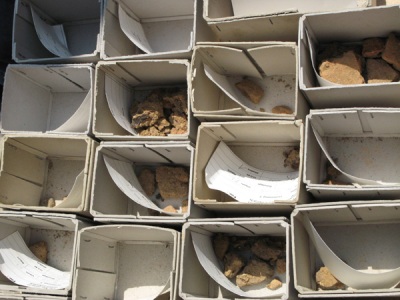In the Swiss national newspaper NZZ, Urs Hafner wrote an eloquent short but critical review of the current Pile dwelling-exhibition in the Bernisches Historisches Museum titled `Historische Phantasie´ (in German). His criticism focuses on the little attention the Neolithisation process gets in the exhibition and the large panels showing scenes of daily live in Neolithic and Bronze Age Pile dwelling villages. (My review can be found here.)

Bauen und Wohnen (Neolithikum) Leucht-Wandbilder (270 x 1000 cm), Ausstellung Die Pfahlbauer – Am Wasser und über die Alpen. Atelier Bunter Hund, in Zusammenarbeit mit illustra.ch. Bernisches Historisches Museum
First, it should be said that by the time of the oldest known Swiss pile dwellings (~4300 BC), the processes of Neolithisation in Switzerland and surrounding areas can be considered concluded (`Neolithic Revolution´ is by archaeologists today seen as an antiquated term). Already 1000 years before the first lake side villages sedentary farmers were living in regions north of the Alps, including Switzerland (e.g. at Gächlingen, Schaffhausen, Bottmingen/Bäumliackerstrasse, Basel and Herznach-Unterdorf, Aargau).
Hafner’s main criticism is the projection of our believes and subjective interpretations on aspects of the lives of past peoples. He wonders whether we know how houses were furnished and whether we actually know if people had chairs and tables in their houses or not. Actually, I believe it can be assumed we do know. As the exhibition shows the preservation at these sites is of such quality that if such items of furniture were common, we would have found them. We also know there were fireplaces in the houses, we know which artefacts were found where within a settlement, so also whether that was within houses or not. We can often tell how certain artefacts were used and what people ate. This amazing range of archaeological evidence allows us many unexpected insights into the daily lives of prehistoric people.
Lastly, archaeology is a science which studies the lives of past people through their material remains. And although we can never assume to be objective – we archaeologists are too much part of our own culture – we have a large and ever-increasing knowledge and understanding of prehistoric people, not in the least because of advances in other scientific subjects with which we cooperate, such as physical anthropology and palaeoenvironmental sciences. But yes, some of our interpretations are just that, interpretations. That is our job as archaeologists, to collect the archaeological evidence using up-to-date scientific methods, to subsequently interpret this evidence to our best ability and share our findings with the public. It goes without saying, we do this from our own position in the world. But doing so we also incorporate the current knowledge base of the discussed period as well as others, here in Switzerland and beyond. Moreover, this is a cumulative knowledge, gathered by scientists throughout the past few hundred years.
The panels in the exhibition show what we know about the people living on the lakes between 4300-800 BC resulting from the described scientific processes and the most likely interpretation of this knowledge. And that there is some fiction in them – as there is in the paintings by Anker albeit far, far more – should be clear to visitors. As archaeologists we use such visualisations to show what we know about (pre-)historic life. The medium dictates that this is impossible without including some fiction, in the same way a historical novel does, although less of course. So, should we make the general public read scientific reports instead? Stop making reconstruction visuals? Stop writing historical novels or cartoons and designing exhibitions? Or provide an accompanying books which are to be read before visiting the exhibition? I think not.
Archaeology and visual representation have a long history together. This includes photography and drawing. Both are an integral part of the archaeological process, drawing arguably a bit more. Drawing is deeply integrated in the archaeological processes of recovery, understanding and interpretation. This already starts during the excavation and continues afterwards. Producing field plans, phase plans and finds drawings help the archaeologist understand the evidence from the past (Wickstead 2008). Scenic reconstructions are a further step in this process. When making a new scenic interpretation of the finds from the Iron Age archaeology at the salt mines of Hallstatt, Rescheiter et al (2013) have written a scientific text to accompany it and explain their decisions on what to show and why. (There exists an extensive literature on the visualisation of archaeology which cannot all be dealt with within the space of a blog post). This will be interesting for fellow scientists, perhaps less so for a general audience in an exhibition. Forster (2012) takes a different approach. She shows the making of a scenic reconstruction of the interpretation of a shepherd’s shelter and the find from it. It poignantly shows what the archaeological evidence is and what interpretation. I could, for example, also imagine documenting the process of the making of scenic panels such as those shown in Bern in film, which can be shown as part of the exhibition. It is now up to the exhibition makers in Bern whether they see it fit to provide more information concerning these panels or not. As an archaeologist I’d be interested in their opinion. Certainly it is in itself a success that the panels are being discussed at all.
That does not take away that to not attempt to interpret would be a serious deficiency on the side of the archaeologists. So it is not that we archaeologists do not want to look upon the `Pfahlbauer´ objectively, or in Hafner’s words `ohne Projektionen´. But firstly these panels might be less subjective than might be expected (we do know, for example that the Lady of Spiez-Einigen was buried lying on a sheepskin) and secondly, we simply have no choice but to be – to some extend – subjective. And even if we could travel back in time, we could still not truly know what it was to be a farmer living on the Lake of Biel in 1800 BC.

Literature
Forster E. (2012). Vom archäoligischen Befund zum Lebensbild, Reitmaier, Th. [Hrsg.], Letzte Jäger, erste Hirten. Hochalpine Archäologie in der Silvretta, Archäologischer Dienst Graubünden, Chur, 67-69. DOI:
Reschreiter, H. , Pany-Kucera, D. & Gröbner, D. (2013). Kinderarbeit in 100m Tiefe? neue Lebensbilder zum prähistorischen Hallstätter Salzbergbau, Karl & R. Leskovar, J. [Hrsg.], Interpretierte Eisenzeiten. Fallstudien, Methoden, Theorie. Tagungsbeiträge der 5. Linzer Gespräche zur interpretativen Eisenzeitarchäologie. Studien zur Kulturgeschichte von Oberösterreich, 37 25-38.
Wickstead, H. (2008), Drawing archaeology, in Duff, L. & Sawdon, Ph. [eds.], Drawing: the purpose. Bristol, U.K., Intellect Books. 13-27

























